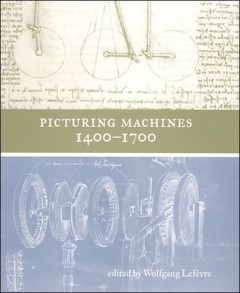Filter by

Picturing machines 1400-1700
How technical drawings shaped early engineering practice.Technical drawings by the architects and engineers of the Renaissance made use of a range of new methods of graphic representation. These drawings--among them Leonardo da Vinci's famous drawings of mechanical devices--have long been studied for their aesthetic qualities and technological ingenuity, but their significance for the architect…
- Edition
- -
- ISBN/ISSN
- 9780262278102
- Collation
- 1 online resource (vi, 347 pages) :illustrations.
- Series Title
- -
- Call Number
- -

Drawing on architecture :the object of lines, 1970-1990
How architectural drawings emerged as aesthetic objects, promoted by a network of galleries, collectors, and institutions, and how this changed the understanding of architecture. Prior to the 1970s, buildings were commonly understood to be the goal of architectural practice; architectural drawings were seen simply as a means to an end. But, just as the boundaries of architecture itself were shi…
- Edition
- -
- ISBN/ISSN
- 9780262344401
- Collation
- 1 online resource (384 pages).
- Series Title
- -
- Call Number
- -

Why Architects Draw
The centerpiece of Robbins's provocative investigation consists ofcase study narratives based on interviews with nine architects, adeveloper-architect, and an architectural engineer. The narratives areillustrated by the architects' drawings from projects in Japan,England, Italy, Germany, Spain, Portugal, and the United States, fromconception through realization.
- Edition
- -
- ISBN/ISSN
- 9780262367783
- Collation
- -
- Series Title
- -
- Call Number
- -

Why architects still draw :two lectures on architectural drawing
"Why would an architect reach for a pencil when drawing software and AutoCAD are a click away? Use a ruler when 3D scanners and GPS devices are close at hand? In Why Architects Still Draw, Paolo Belardi offers an elegant and ardent defense of drawing by hand as a way of thinking. Belardi is no Luddite; he doesn't urge architects to give up digital devices for watercolors and a measuring tape. R…
- Edition
- -
- ISBN/ISSN
- 9780262321426
- Collation
- 1 online resource (133 pages)
- Series Title
- -
- Call Number
- -

Why architects draw
Examines the social uses of architectural drawing: how it acts to direct architecture; how it helps define what is important about a design; and how it embodies claims about the architect's status and authority. Case study narratives are included with drawings from projects at all stages.OCLC-licensed vendor bibliographic record.
- Edition
- -
- ISBN/ISSN
- 0262367785
- Collation
- 1 online resource (315 pages) :illustrations.
- Series Title
- -
- Call Number
- -

Resetting the International Monetary (Non)System
This book provides an analysis of the global monetary system and the necessary reforms that it should undergo to play an active role in the twenty-first century. As its title indicates, its basic diagnosis is that it is an ad hoc framework rather than a coherent system—a ‘non-system’—which evolved after the breakdown of the original Bretton Woods arrangement in the early 1970s. The book…
- Edition
- -
- ISBN/ISSN
- 9780198718116
- Collation
- -
- Series Title
- -
- Call Number
- -

Fabricate 2011
FABRICATE is an international peer reviewed conference that takes place every three years with a supporting publication on the theme of Digital Fabrication. Discussing the progressive integration of digital design with manufacturing processes, and its impact on design and making in the 21st century, FABRICATE brings together pioneers in design and making within architecture, construction, engin…
- Edition
- -
- ISBN/ISSN
- 9781787352131
- Collation
- -
- Series Title
- -
- Call Number
- -
 Computer Science, Information & General Works
Computer Science, Information & General Works  Philosophy & Psychology
Philosophy & Psychology  Religion
Religion  Social Sciences
Social Sciences  Language
Language  Pure Science
Pure Science  Applied Sciences
Applied Sciences  Art & Recreation
Art & Recreation  Literature
Literature  History & Geography
History & Geography